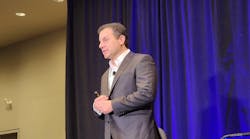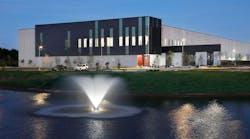Two of the data center industry’s most experienced thought leaders will steer the future of an emerging specialist in software-defined power. Virtual Power Systems announced today that Dean Nelson has been named interim CEO, while Peter Gross will be the company’s new Chairman of the Board.
Nelson, who has held data center leadership positions at Uber, eBay and Sun Microsystems, replaces Steve Houck as CEO. Gross, a pioneer in data center design and power at EYP, HP and Bloom Energy, succeeds William Clough as board chair. Clough will now serve as vice chairman of the board.
“VPS has created a new market category with its Software-Defined Power (SDP) architecture which significantly increases power utilization and resiliency for data centers,” said Rajeev Madhavan, founder of Clear Ventures, a VPS board member and investor. “We look forward to leveraging Dean and Peter’s experience to help transition the company to its next phase of growth.”
Virtual Power Systems is a startup that offers software, hardware appliances and lithium-ion batteries to optimize power distribution within a data center. As with server virtualization, software-defined power offers the promise of bringing new levels of efficiency and automation to data centers. That includes reallocating power from underused racks to IT gear that needs additional power.
Software-defined power is similar in concept to the role lithium-ion batteries play in a hybrid car, providing energy as needed, and then charging when not in use. Data center batteries and IT resources are managed by a software suite created by Virtual Power Systems. This approach effectively creates pools of power that can be applied to IT assets in a granular fashion.
Software as a Game Changer for Power Efficiency
Gross is a long-time advocate of innovation in data center power, and has served on the board of VPS since 2014. He said Nelson is the right leader to boost the profile of VPS and make the case for software-defined power technology.
Peter Gross, Chairman of the Board for Virtual Power Systems (Photo: Infrastructure Masons)
“Dean is a visionary with an outstanding track record in growing companies and driving industry-leading innovations,” said Gross. “The VPS Software-Defined Power platform comes at the right time as data center facilities experience explosive growth and cost reduction challenges requiring a smarter way to provision, manage and utilize power. I’m pleased to continue William Clough’s excellent work as Chairman and support Dean and his team to advance VPS’s success.”
Nelson said the explosive growth of data and digital infrastructure mandates new thinking, especially on power efficiency.
“There’s a data tsunami coming as the next two billion people come on-line and global users continue to generate and consume more data with the advent of 5G,” said Nelson. “This will trigger unprecedented global data center growth. Now is the time to implement Software-Defined Power as data center efficiency will be at a premium and a defining factor in the success or failure of an operation. I’m excited to help Virtual Power Systems provide this game-changing software to unlock stranded power and dynamically manage capacity reducing costs and increasing resiliency for global data center operators.”
Peak Shaving Enables Elastic Power Management
Virtual Power Systems uses a combination of software and distributed batteries to conduct peak shaving, using the batteries to store power and allocate it to the system when needed, creating a more elastic system for distributing power. The batteries and power flows are managed by the company’s ICE (Intelligent Control of Energy) software suite, which allocates power from by utility sources, UPS systems and batteries.
Virtual Power Systems creates a “hardware-agnostic power control plane,” with the ICE software sitting between the power hardware and the IT equipment. ICE software connects with power and IT systems over Ethernet, collects power use data at server, rack, row and data center level, and intelligently controls power distribution in and to racks.
VPS has worked primarily with lithium-ion batteries, but the company has also recently begun working with sodium-ion technology from Natron Energy, which offers the potential to pack more capacity in a smaller footprint, as well as faster recharging.
Virtual Power Systems also has developed a cloud platform that can provide centralized management, a feature that would enable users to manage assets across a geographically distributed portfolio.
Virtual Power Systems raised $17 million last year in a Series B funding led by led by power equipment vendor CUI Global with participation from a group of existing investors. CUI Inc. launched the first commercial product based on VPS technology in March 2018, when it began selling a UL-certified ICE Block lithium-ion battery appliance.
A Vision for the Disruptive Power of Software
Nelson recently spoke with Data Center Frontier about his enthusiasm for VPS and its technology. He joined the company’s board last year, and embraces Marc Andreessen’s belief that “software is eating the world,” a trend that includes the data center.
“There’s tens of billions of dollars in capacity of data centers that is unused,” said Nelson. “I’m working on expanding the software-defined data center. What it’s been missing is virtualization on the facilities side. It took a long time in IT, but we want to apply that to the physical data center.”
For data center operators, adopting software-defined power means letting go of long-held standards that focus on reliability through hardware redundancy, including the Uptime Institute’s Tier System, which rates data centers based on how they configure power equipment like UPS units and backup generators. Gross has experience with this challenge from his past work with Bloom Energy, whose fuel cell UPS systems also disrupt the traditional configurations.
Nelson says the potential savings makes software-defined power an important technology to perfect and implement in multi-tenant data centers. It’s definitely possible, he said, as hyperscale providers already have similar systems.
“The cloud players have been doing this,” said Nelson. “We know the hyperscalers have orchestration in place. They can’t get this capability in the colos. (Meanwhile) you’re hitting the floor in terms of pricing and margin. Colo margins are going away. But not if you can marry load with actual supply.”
As an example, Nelson noted the widespread use of redundant power distribution infrastructure, typically configured through A and B feeds with identical infrastructure. Given the cost of power and hardware, it’s an expensive way to manage redundancy, Nelson says.
“What if you could use that A and B capacity and drive utilization up?” he said. “It needs local energy storage to enable that ride-through and peak-shaving. You can offer a lower cost per kilowatt and still meet the SLAs. This is a competitive advantage because they can offer a lower cost of power. It drops the entire cost per kW.
“The only company doing this has been VPS,” said Nelson. “The data center industry needs to adopt software-defined power, software-defined cooling, and local energy storage. We have to trust that software can do what it did in (IT) virtualization.”






